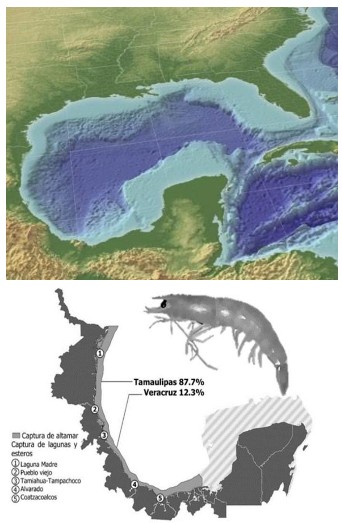Fishery Improvement Project
Last Update: December 2024
Species: Brown Shrimp fishery (Farfantepenaeus aztecus)
Fishery Location: Mexican waters, Tamaulipas.

FIP Coordination
If you would like more information about the FIP or if you wish to support it, please contact Brigitte Alcántara.
FIP Partners
- Congeladora Rey Mar (local exporter)
- Porto Jaibo (local exporter)
- CeDePesca (Technical support)
Date Publicly Announced: N/A
FIP Documents
Pre-Assessment
Specific Agreement N1 (see Annex I for FIP Action Plan)
Sustainability information:
FishSource – Brown shrimp – Gulf of Mexico continental shelf (Tamaulipas (focused on the fishery for direct human consumption)
Other references:
Current Improvement Recommendations:
- Regular stock assessments must be publicly accessible and peer reviewed. Reference points must be known to understand the status of the stock.
- Systematic bycatch information is required to be collected on at least 20% of the UoC-associated fleet fishing trips by on-board observers and electronic means. This information is necessary to understand the impacts of the fishery on other components of the ecosystem and to determine if measures are necessary to mitigate them.
- Besides adopting more precise goals for the ecosystem components of the fishery, it is necessary to reinstate regular participatory mechanism to incorporate INAPESCA from fishers, permit holders, and processors, where the current system efficacity is evaluated, the scientific findings are shared, and the necessary measures can be debated and advised to the fishing authority.
Quick view
| Categories: | Shrimp, Lobster and Crab |
| Last Update: | December 2024 |
| Species: | Brown Shrimp fishery (Farfantepenaeus aztecus) |
| Fishery Location: | Mexican waters, Tamaulipas |
Background
The brown shrimp (Farfantepenaeus aztecus) is distributed along the Atlantic coast from Massachusetts to Yucatan, Mexico. It is a highly productive species due to its rapid growth, short life span, and high fecundity, with widely dispersed offspring. The abundance of this species is highly dependent on environmental conditions. The brown shrimp is omnivorous, feeding on detritus, algae, and small invertebrates, and reproduces year-round, with peaks in two specific periods.
The shrimp population is very dynamic, with smaller individuals growing rapidly to commercial sizes and adults continually moving into marine areas. Females are more abundant than males throughout the year.
Fishing methods for this species include bottom trawling, primarily conducted offshore using twin nets to capture shrimp. This method is widely employed due to the species’ significant role in the commercial shrimp industry.
Brown shrimp is the predominant species caught in the northern Gulf of Mexico, particularly in Tamaulipas, where it represents 91% of total production. The average annual catch of this species during the last decade (2009-2019) has been approximately 11,379 tons, coming from both lagoons and the high seas in the states of Tamaulipas and Veracruz.
FIP Objectives:
At the time of drafting this report, FIP objectives are considered to be:
1. Increase the transparency of stock assessment procedures and outcomes.
- Promote regular publication of stock assessments.
- Promote the definition of biological reference points against which the status of the stock can be assessed.
- Promote peer review of stock assessments and analysis of alternative assessment models.
2. Development of harvest strategies and promote improvements in the fishery management system.
- Development and implementation of Harvest Control Rules (HCR).
- The Management Plan is required to include specific operational objectives in relation to bycatch.
- Form a participatory Management Commission (or similar) where the effectiveness of those measures adopted in the past is evaluated.
- Demonstrate that there is an effective monitoring and surveillance system
3. Understand and mitigate impacts on the ecosystem.
- Implementation of an Observer Program to gather systematic information on fishing trips.
- The impacts will be evaluated quantitatively through models or qualitatively through risk analysis.
Progress Update
2024
July 2024
In July, the partners agreed to develop an Improvement Project for the brown shrimp (Farfantepenaeus aztecus) fishery in the northern Gulf of Mexico, Tamaulipas. As part of this agreement, the Action Plan for the fishery was approved and formalized through a specific agreement, which also includes the implementation of the On-Board Observer Program (POAB).
